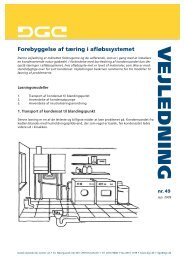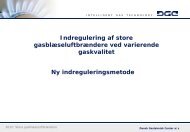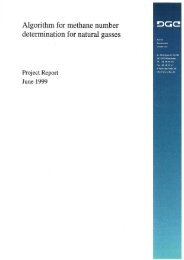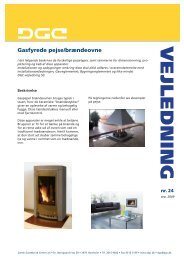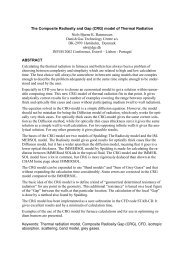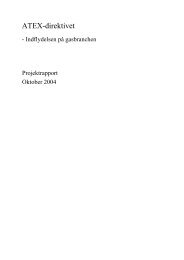GASQUAL project - Danish Gas Technology Centre
GASQUAL project - Danish Gas Technology Centre
GASQUAL project - Danish Gas Technology Centre
You also want an ePaper? Increase the reach of your titles
YUMPU automatically turns print PDFs into web optimized ePapers that Google loves.
International <strong>Gas</strong> Union Research Conference 2011<br />
<strong>GASQUAL</strong> <strong>project</strong>: a step closer to gas quality harmonization in Europe<br />
Authors:<br />
Jean Schweitzer<br />
<strong>Danish</strong> <strong>Gas</strong> <strong>Technology</strong> Center<br />
Denmark<br />
Coordinator <strong>GASQUAL</strong><br />
F. Cagnon<br />
GDF SUEZ – DRI-GRIGEN<br />
France<br />
Convenor CEN BT WG 197
ABSTRACT<br />
The growing importance of LNG, the liberalisation of energy markets, the security of supply<br />
are among the factors that make us able to take future variation of gas quality for granted.<br />
The European gas industry has identified that gas quality specification would need<br />
harmonization to allow for improved interoperability already in 2001. A first step was achieved with the<br />
publication of the EASEE-gas Common Business Practice on gas quality in 2005. However this work<br />
didn't address the issues related to combustion parameter.<br />
Thus the European Commission has launched investigations on acceptable harmonised limits<br />
for H gas quality in EU regarding combustion parameters and primarily the Wobbe Index. This study<br />
will be used as main input for the work of CEN (Comité Européen de Normalisation i.e. the European<br />
Standardisation Organisation) and should result in a standard for natural gas quality within the next 3<br />
years.<br />
The paper will present the state of play at the beginning of the exercise, with gas quality<br />
specification being specified at a national level. Then it will present the work conducted by Marcogaz<br />
and EASEE-gas up to the subsequent introduction of the standardisation work launched by the<br />
European Commission.<br />
The paper will also bring details on the investigations carried out in Europe in order to quantify<br />
the impact of future changes in gas quality ranges distributed in the EU (<strong>GASQUAL</strong> <strong>project</strong>).
1. INTRODUCTION<br />
The changes in the Energy market in European Union means that the gas industry has been<br />
separated between the infrastructure operators, responsible for transmitting, distributing and storing<br />
gas that are supervised by the Energy Regulation Agencies, and the commercial activities i.e. the<br />
people buying and selling gas. Those later have to use the infrastructures of the former in order that<br />
gas can reach its customers from the entry points of the networks. Thus the access conditions to the<br />
infrastructure shall be transparent. Furthermore their activities imply that gas is bought and sold<br />
regardless of the physical movement of the gas and thus the gas system shall operate at EU level<br />
without hindrance.<br />
Although the current specifications allowed for the smooth circulation of gases from the main<br />
supply areas to the consumption areas, as presented in Figure 1, those historical flow could be<br />
reversed.<br />
Figure 1: EU main gas flows.<br />
It is especially in the red area where the flow can change due to market based movement. The<br />
Interconnector, linking UK to the continent is already operated in both directions quite frequently as is<br />
the case for the pipelines between Germany and Belgium. Reverse flow from France to Belgium or<br />
Germany has not occurred yet but very low flow situation has already been observed.<br />
The <strong>GASQUAL</strong> <strong>project</strong> is aiming at bringing light on the impact of gas quality changes in the<br />
EU. For this complex question one need to know about the actual situation that is different by country.<br />
Some countries where the gas distributed is quite stable and deviates from G20 (pure<br />
methane, for which most appliances are set at the production) have allowed for adjustment of<br />
appliances on site, some other countries did not allow for such adjustments (about 10 millions<br />
appliances can be adjusted on a total of 167 Millions).<br />
Also the market profile is also very different by countries, some countries having a lot of<br />
cookers, some other having mostly fully premix burner boilers etc..<br />
This leads to a complex situation. On the one hand, a harmonized narrow range of Wobbe<br />
index that is common to all countries would compromise the safety of supply and/or raise gas costs.
On the other hand a harmonized Wobbe range larger than one's national range shall be considered<br />
cautiously to avoid added risks to the gas customers.<br />
The study performed under supervision of CEN BT WG 197 by the <strong>project</strong> <strong>GASQUAL</strong> shall<br />
bring light on how the 200 Million or more GAD compliant appliances installed in the EU will behave<br />
when the gas quality will vary, looking at safety aspects but also possible operational issues and<br />
impact on efficiency and NOx emissions.<br />
The appliances under study are those compliant to the <strong>Gas</strong> Appliance Directive (90/396/CE)<br />
and thus installed after about 1992. It is only since that date that all appliances sold in EU are certified<br />
against a common reference, EN 437, as regards gas quality range and pressure. Impact of gas<br />
quality variations on older appliances are to be treated nationally.<br />
2. THE NATIONAL GAS QUALITY SPECIFICATIONS<br />
Marcogaz, the European Technical <strong>Gas</strong> Association, published in 2002 a report presenting the<br />
situation for gas quality specification in 8 European countries accounting for 84 % of the EU gas<br />
consumption. The first finding was that the parameters used for gas specifications were not always the<br />
same. Furthermore, some parameters are defined in a law or a national technical specification when<br />
others are defined in contractual agreements. Table 1 summarises this situation. All countries have a<br />
specification on Wobbe index, water, total sulphur and H2S reflecting the sensitivity of utilisations and<br />
infrastructure to these specifications. Hydrocarbon dew point and GCV are often specified. Impurities<br />
are also often mentioned although as a general statement about absence of impurities.<br />
Table 1: Reference conditions and parameters in some EU countries. (Source Marcogaz)<br />
Be Dk De F It Nl Sp UK Total<br />
Reference Temp. (°C):<br />
Volume<br />
Energy<br />
0<br />
25/0<br />
0<br />
25/0<br />
0<br />
25/0<br />
0<br />
0/0<br />
15<br />
15/15<br />
0<br />
25/0<br />
0<br />
0/0<br />
15<br />
15/15<br />
Coefficient for energy conversion 0.949 0.949 0.949 0.946 1 0.949 0.946 1<br />
GCV L L L L O L 6/8<br />
Wobbe index L L L O L O O L 8/8<br />
Density L L L 3/8<br />
Methane number 0/8<br />
Hydrocarbon dew point O L L O L O L 7/8<br />
Water dew point O L L L L O O L 8/8<br />
Total L L L L L O O L 8/8<br />
Sulphur<br />
H 2 S L L L L L O L L 8/8<br />
Odorant L L O L O 5/8<br />
Mercaptan L L O 3/8<br />
Comb. Potential O 1/8<br />
Other indices<br />
Ij O 1/8<br />
ICF L 1/8<br />
Soot index L 1/8<br />
CO O L 2/8<br />
Carbonyl metals O 1/8<br />
Impurities (liquids, solids) L L O L O L 6/8<br />
CO 2 O L O O 4/8<br />
N 2 O 1/8<br />
O 2 L O L O L 5/8<br />
H 2 O L 2/8<br />
Aromatic O 1/8<br />
NH 3 L 1/8<br />
Notes: L means that the specification is defined by the law or a technical code/specification<br />
valid for the country. O means that the specification is only contractual. Odorisation is a legal
obligation in all countries. The "L" in the table for odorant means that the type and/or concentration of<br />
odorant are specified by national regulation or technical rules.<br />
For those parameters that are specified in all countries, some differences can be observed in<br />
values or formulation. For instance water specification can be formulated as a given dew temperature<br />
for a given operating pressure, a given dew temperature at the maximum operating pressure of the<br />
network without precision about this pressure or as a requirement that no liquid water shall be<br />
observed at pipe conditions (i.e. at ground temperature and maximum operating pressure). In any<br />
case, the requirement would give similar maximum allowable water content if one considers high<br />
pressure transmission lines, reflecting the need for transmission network operators to protect their<br />
system of water corrosion and hydrate formation.<br />
For sulphur specifications (see Figure 1 2), although H2S specifications are very similar in all<br />
countries reflecting the need to limit this component detrimental to high pressure steel pipes, the total<br />
sulphur specifications are quite different with a number of countries allowing around 150 mgS/m 3 (n)<br />
and other around 30 mgS/m 3 (n). The reason for differences is to be found in the history of indigenous<br />
supplies that could contain quite a lot of sulphur specially in France and Italy.<br />
Figure 2: Sulphur specification (source Marcogaz).<br />
180<br />
160<br />
Total S<br />
H2S*10<br />
Total Sulphur or H2S*10 - mgS/m3(n)<br />
140<br />
120<br />
100<br />
80<br />
60<br />
40<br />
20<br />
0<br />
Be Dk De F It NL L NL H Sp UK<br />
Country<br />
Note: H2S concentrations multiplied by 10 for scaling purposes.<br />
Another very important parameter in EU is the Wobbe index as it is used for interchangeability.<br />
The current EU interchangeability approach is based on EN 437 "Test gases, test pressures,<br />
Appliance categories". This standard defines three categories of gases according to their Wobbe index<br />
(manufactured gas, natural gas and LPG). For natural gases three groups are defined:<br />
- Group H for gases with a Wobbe index between 45.7 and 54.7 MJ/m 3 .<br />
- Group L for gases with a Wobbe index between 39.1 and 44.8 MJ/m 3 .<br />
- Group E for gases with a Wobbe index between 40.9 and 54.7 MJ/m 3 .<br />
All EU countries, according to the type of gases that can be distributed within their borders,<br />
are asking that the appliances sold in their countries have to be marked L, H or E, i.e. tested against<br />
and certified for one of the three groups. However, the actual ranges of Wobbe index that are
specified in the different countries are quite different from the limits of EN 437 and different for each<br />
country (see Figure 3). This is because the current national ranges are largely based on the legacy of<br />
the national certification schemes that were in force before the EU <strong>Gas</strong> Appliance Directive entered<br />
into force with the certification scheme of EN 437 in 1993.<br />
With that former national approach, each country developed a gas industry based on its<br />
available supplies. Thus the appliances were built by national manufacturers so they can use the gas<br />
quality that were available this situation being then reflected by national standards. For instance UK<br />
used to be isolated with lean gases from the UK continental shelf and thus uses a narrow and low<br />
range whereas Belgium or France having to get their supply from outside the country started very<br />
early to use rich LNG's but also leaner gases from Russia or L gases from the Netherlands. Spain<br />
developed a nationwide transmission system for natural gas in the beginning of the 90's and thus<br />
considered that there was no legacy, thus all the appliances present in the country are certified<br />
against EN 437 H range and can use full the H range.<br />
Figure 3: Wobbe range in EU (Source Marcogaz).<br />
60<br />
Wobbe number (MJ/m3 15°C/15°C))<br />
55<br />
50<br />
45<br />
40<br />
35<br />
Be L F L Nl L De L Be H Dk De H F H It NL H Sp UK<br />
Minimum value Maximum value Usual values Min L<br />
Max L Max H & E Min H Min E<br />
All these differences mean that a gas circulating in a country may not be accepted in the next<br />
one. For instance most of the LNG arriving in the Zeebrugge terminal cannot be sent to UK via the<br />
interconnector as they are too rich for UK regulation.<br />
3. EASEE-GAS COMMON BUSINESS PRACTICE ON GAS QUALITY<br />
In 2002 EASEE-gas launched a Working group for the harmonisation of gas quality. As an<br />
association of stakeholders in Europe, EASEE-gas prepared Common Business Practices (CBP), i.e.<br />
non binding rules that should be seen as references by its adherents. The Common Business Practice<br />
on <strong>Gas</strong> Quality was first published in 2005, its revised version as for November 2008. It was prepared<br />
with the objective to define, for a minimum set of parameters, specifications acceptable by all parties.<br />
These specifications apply at cross borders point and exit point of LNG terminals and are applicable<br />
only to H gases without added odorant. <strong>Gas</strong>es complying with the CBP shall not be rejected.<br />
However, gases outside these specifications are free to circulate providing that a bilateral agreement<br />
exists at the given border point.
Table 2 presents the specifications as defined in EASEE-gas CBP. Water and hydrocarbon<br />
dew points, CO2, Oxygen and sulphur values are more or less reflecting the current specifications as<br />
identified by Marcogaz, although the principle being that the specification is acceptable by all parties<br />
means that it is generally the stricter values that have been retained in the CBP. Nevertheless these<br />
specifications, sometimes identified as pipeline requirements as they are mainly addressing<br />
infrastructure operator's needs, are more or less implemented.<br />
As for the Wobbe index specification, the values are based on a proposal by Marcogaz that<br />
considers that:<br />
- harmonisation of this parameter could be undertaken only for modern appliances<br />
certified against the scheme of EN 437.<br />
- these appliances being sold all over EU are using a wide range of gases without<br />
known adverse effect and thus a common gas quality could be defined based on the<br />
actual range of gases distributed within Europe.<br />
Furthermore, to cover secondary interchangeability parameters such as the soot index defined<br />
in the UK specifications, relative density was proposed. By limiting the relative density to 0.7 it limits<br />
the C3+ fraction in the gas that is the main influence parameter in the calculation of the soot index as<br />
defined by Dutton.<br />
Table 2: EASEE-gas <strong>Gas</strong> quality CBP specifications.<br />
Parameter Unit Min Max<br />
Wobbe index 1 MJ/m 3 46.44 54<br />
Relative density 0.555 0.70<br />
Total Sulphur 2 mgS/m 3 30<br />
H 2 S + COS Sulphur mgS/m 3 5<br />
Mercaptan Sulphur mgS/m 3 6<br />
Oxygen Mol% 0.001<br />
CO 2 Mol% 2.5<br />
Water dew point °C at 70 bar -8<br />
HC dew point °C from 1 to 70 bar -2<br />
The Wobbe range as proposed by Marcogaz and EASEE-gas has been challenged by several<br />
players of the gas industry on the basis that, although new appliances could use the whole EN 437<br />
range, the proposal didn't take into account the possible changes induced by appliance aging and field<br />
adjustment. Furthermore, as no country was distributing gases covering the whole proposed range,<br />
the available experience was not sufficient to support that range. Thus further studies were needed.<br />
4. THE CEN MANDATE<br />
For this reason, the European Commission asked CEN, the European Committee for<br />
Standardisation, to evaluate the impact of gas quality variations on the behaviour of gas appliances<br />
and to produce a standard on <strong>Gas</strong> Quality based on this evaluation, EASEE-gas CBP and a cost<br />
benefit analysis entrusted to consultants by the European Commission.<br />
CEN accepted this mandate in March 2007 and created CEN BT WG 197 to study the impact<br />
of gas quality variations on appliances. The actual work was subcontracted to a consortium of 15 EU<br />
partners and laboratories led by the <strong>Danish</strong> <strong>Gas</strong> <strong>Technology</strong> Center (<strong>GASQUAL</strong>) and started in<br />
January 2009.<br />
1 Original values for the Wobbe index (13.6-15.81) are given in kWh/m 3 with reference conditions 25°C, 0°C<br />
and 1013.25 hPa. They have been converted to MJ and to the ISO recommended reference conditions.<br />
2 For concentrations values, the volume reference conditions are 0°C, 1013.25 hPa.
4.1. <strong>GASQUAL</strong> PROJECT<br />
The study is divided in 6 work packages as described in Figure 4. The first 3 work packages<br />
are dedicated to the knowledge of the existing population of appliances that are complying with the<br />
<strong>Gas</strong> Appliance Directive and to identify the potential sources of divergence due to certification<br />
practices or during the life of the appliances.<br />
Figure 4: Study of the impact of gas quality variations.<br />
Based on the results of these three work packages a testing programme has been prepared<br />
and a sample of appliances been constructed. About a hundred appliances have been tested during<br />
the course of the programme that has been completed by June 2011. The conclusions are expected in<br />
September 2011 as CEN BT WG 197 shall give its recommendations for drafting the standard in<br />
December 2011.<br />
4.2. <strong>GASQUAL</strong> TEST PROGRAMME<br />
Although most gas appliances such as cookers, water heaters and atmospheric boilers are<br />
installed without modification of the factory settings, high performance condensing boilers, generally<br />
equipped with a full premix fanned burner, may be adjusted to achieve the same air gas ratio with the<br />
gas distributed as the one observed with the reference gas, G20 that is pure methane. This<br />
adjustment may be recommended by manufacturers in order to ensure that the appliance achieves its<br />
best performances in terms of NOx emissions and efficiency. However, this adjustment implies that<br />
the safe working range of the appliance may be shifted with the set point and that the appliance may<br />
not be able to use safely the whole range of gases for which it has been certified.<br />
Thus a testing programme has been built to check the impact of gas quality variations on the<br />
safe operation, NOx emissions and efficiency of appliances. The testing programme is using a number<br />
of test gases around the domain described in Figure 5 (blue shape). The E1 gas is pure methane that<br />
is also the reference gas defined in EN 437 when certifying appliances for the H group. Appliances are<br />
tested with A1 gas which is slightly richer than the higher limit of the H range to take into account<br />
uncertainty on the test gases. The leanest gas used is the lower limit of the H range. <strong>Gas</strong>es D4, E6<br />
and F6 are used to evaluate the sensitivity of the appliances to high density gases. The purpose of the<br />
work is to monitor the operation of the appliance on E1 and the extreme gases. If any malfunction or if<br />
safety is degraded with one of the extreme gases then the operation is repeated with the next test gas,<br />
going back toward E1 (for instance from A1 to B1, C1 etc.).
Figure 5: Test gases used in the <strong>GASQUAL</strong> study.<br />
This testing pattern is applied on a sample of about 100 domestic appliances chosen to<br />
represent 28 segments representing the various types of appliances and technology identified by the<br />
work package 1 to 3. Furthermore, to take into account the possibility that some appliances may have<br />
been adjusted to local gas quality during installation or while servicing, those appliances for which the<br />
air gas ratio can be changed are adjusted successively on gas B1 and gas G1. These gases<br />
represent, with a margin, the richest and leanest gases that are to be found on EU networks<br />
represented by the purple markers of Figure 5. After each adjustment the testing is repeated.<br />
For commercial appliances no tests have been carried out, but conclusions should be<br />
extrapolated for the test results obtained on similar technologies from the domestic appliances testing.<br />
The EASEE-gas proposal is defined by the green rectangle (dotted lines). The<br />
methane/propane and methane/nitrogen binary mixtures delimitating the blue shape have been<br />
chosen in reference to Dutton interchangeability method and are quite correctly delimitating the<br />
envelope of possible natural gases. Actually to observed gases on the left of the blue shape in that<br />
Wobbe index vs. Relative density system would mean that hydrogen have been injected in the gas.<br />
Although this might be the future, it has not been addressed in this work.<br />
The <strong>GASQUAL</strong> way to assess results is a bit different compared to the EN 437. While the<br />
standard is looking at absolute value of CO for various gases, <strong>GASQUAL</strong> is merely looking at the<br />
variation of CO and other characteristics with gas quality. Also in order to have clear picture of this<br />
impact we have used intermediate gases compared to the usual EN 437 limit gases. See on Figure 5<br />
the gases used for <strong>GASQUAL</strong> (A1, B1, C1 etc..) and the limit gases (G21, etc…). Furthermore in the<br />
spirit of EN 437, the limit gases are meant to simulate unusual conditions where high or low Wobbe<br />
gases are on the net for a limited time. <strong>GASQUAL</strong> tests are done in the spirit that those gases can be<br />
normally distributed.
4.3. <strong>GASQUAL</strong> FEW RESULTS<br />
The extended results and conclusions are not available at the date of preparation of this<br />
paper, however a number of trends can already be seen from the appliances tested.<br />
One of the main parameters appears to be the possible adjustment of the appliance. The<br />
adjustment we are talking about here is based on CO2 or O2 measurement in the combustion<br />
products and the adjustment is done to reach a given value of O2 or CO2 given by the manufacturer.<br />
- Appliances that are adjusted on G20 can work over the range 46-55 MJ/m 3 (15°C,<br />
15°C and 1013.25 hPa), without an unacceptable incr ease of CO nor other safety or<br />
operational issues. Possible long term effects are still under investigation<br />
- Appliances that are adjusted with gases at the maximum or minimum of the range<br />
investigated (46-55 MJ/m 3 ) are generally giving issues for Wobbe opposite to the set<br />
point (adjusted with lean gas giving issues with rich gas and the other way round)<br />
Figure 6: Example of impact profile on a specific adjustable appliance<br />
Nominal Ws: H1 G1 F1/F6 E6/E1 D1/D4 C1 B1 A1<br />
Ws 45 46 47 48 49 50 51 52 53 54 55 56<br />
E1<br />
B1<br />
G1<br />
The adjustments simulated by the <strong>GASQUAL</strong> tests are however extremes. In practise<br />
appliances can only be adjusted with the gas that has effectively been distributed in the given country.<br />
The Wobbe range of gas distributed is much narrower than the range investigated here, so to have a<br />
realistic idea of the impact it is necessary to take into account the real gas distributed and the<br />
adjustment policy in a given country. The combination of both with the impact profile will tell about the<br />
impact in the given country. So in short the same appliance may behave differently in different places<br />
if the gas distributed during adjustment is different.<br />
Figure 7: Exemple of test result including 3 different gases for adjustment.<br />
1800<br />
1600<br />
1400<br />
CO, ref [ppm]<br />
1200<br />
1000<br />
800<br />
600<br />
E1 adjustment<br />
B1 adjustment<br />
G1 adjustment<br />
400<br />
200<br />
0<br />
-10 -5 0 5 10<br />
Wobbe,test - Wobbe,set [MJ/m3]<br />
The test results obtained for some of the segments (as in the example above fully premix<br />
condensing boilers) are showing that CO emissions are depending of the difference between the<br />
Wobbe used for the adjustment and the Wobbe of the gas used for the test independently of the gas<br />
used for the setting (see Figure 7).
Such result /curve can therefore be used to predict the behaviour of an appliance to various<br />
Wobbe range scenarios in a given country when knowing the range gas really distributed (when<br />
adjusted the appliance was set with a gas in the range distributed).<br />
Moreover results of that sort obtained during the <strong>project</strong> can be used in the future to adjust<br />
(when relevant) appliances so to optimize their ability to cope with larger gas quality variations.<br />
The limitation of some appliances (on the market) to cope with larger gas quality variations is<br />
very linked to the fact that they have been optimized for Low NOx or High efficiency. Those<br />
adjustments bring the appliances in setting where sometimes Wobbe variation will result in noticeable<br />
CO increase.<br />
The test data we have gathered is showing how those appliances can easily be set (adjusted)<br />
in order to limit the CO increase in case of Wobbe variation. The “cost” of such will of course be a<br />
slight decrease of efficiency or increase of NOx emissions.<br />
4.4. OTHER EXPERIMENTAL RESULTS<br />
The experiments have given other interesting results as the influence of other parameters:<br />
- Only few burner technologies are really reacting differently to the gas relative density<br />
within the range studied. In the majority of appliances tested the density of the gas has<br />
an influence that is not measurable and only the Wobbe index is really having an<br />
influence.<br />
- The gas pressure is often acting as worsening parameter. In many cases the Wobbe<br />
index change alone will lead to negligible CO increase but combined to increase or<br />
decrease of gas pressure (respectively 25 mbars or 15 mbars were tested), it leads to<br />
un-acceptable CO increase. The presence of a pressure regulator on the appliance or<br />
gas line would of course resolve this in most of the cases.<br />
5. CONCLUSION<br />
<strong>Gas</strong> quality specifications are necessary to insure the safe and efficient operation of the gas<br />
system and uses. In Europe they are defined on a national level and incorporate the legacy of the<br />
national gas industries. In those specifications one can see the history of supplies and of the gas<br />
system.<br />
<strong>Gas</strong> systems are using more and more similar technologies and materials meaning that the<br />
basic requirements for their safe operation are similar European wide. This is reflected in the<br />
agreement that has been found on the pipeline parameters in EASEE-gas CBP. The legacy of existing<br />
appliances, because of their number and diversity, is more difficult to overcome and needs careful<br />
consideration. To distribute a wide range of gases would mean a cheaper energy supply but may<br />
impose some high constraint on the appliances detrimental to their costs. On the other hand having a<br />
tight specification would mean a reduction of the gas supply or an increase of its cost. An adequate<br />
balance shall be found.<br />
To help the decision process, the <strong>GASQUAL</strong> <strong>project</strong> results should bring light and figures for<br />
finding this balance. The <strong>GASQUAL</strong> <strong>project</strong> result will also open for the development of adapted<br />
solution when needed.


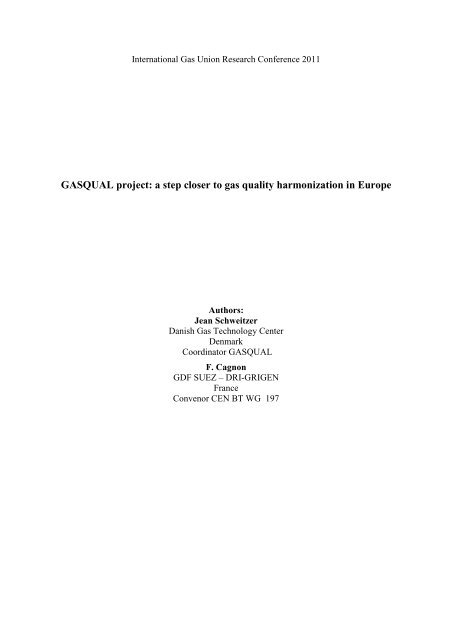
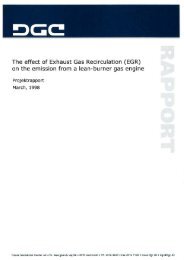

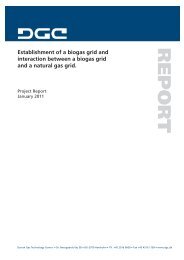
![Hybrid heating systems and smart grid [PDF] - Danish Gas ...](https://img.yumpu.com/46620218/1/184x260/hybrid-heating-systems-and-smart-grid-pdf-danish-gas-.jpg?quality=85)
